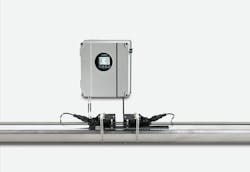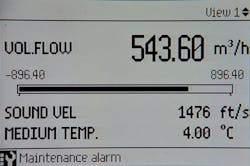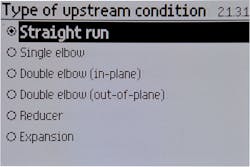Simplifying clamp-on ultrasonic flow systems
Clamp-on ultrasonic flowmeters are among the most cost-effective technologies for measuring the volumetric flow rate of liquids. As their name suggests, clamp-on sensors are mounted to the exterior of a pipe, eliminating the need for line alterations or process shutdown prior to installation. Their nonintrusive nature also keeps maintenance requirements to an absolute minimum because the sensors never come into contact with the fluid.
Yet, despite their low cost of ownership and increasingly advanced capabilities, clamp-on flowmeters have been slow to gain acceptance from engineers and plant managers as an ironclad alternative to traditional methods of flow measurement. Many end users are reluctant to switch because they perceive clamp-on meters as overly complicated to use and install.
To bridge this gap and successfully integrate clamp-on technology into a broader segment of the process industries, instrumentation suppliers are integrating a higher level of user-friendliness into the next generation of clamp-on ultrasonic flow systems.
A demanding technology
Getting a clamp-on meter up and running can be an involved process — calling for more technical knowledge than most other types of flowmeters. But why is this the case?
The challenge is that clamp-on sensors or transducers are available in three different models — universal, high-precision and high-temperature to address a wide range of media, pipe materials and operating environments. Most suppliers also offer multiple sizes of each model to ensure the best possible match between the frequency of the sensor and that of the pipe wall. To order a flow system, the customer must know how to determine the correct model and size for their specific application, as well as how to select the appropriate transducer mounting accessories for the chosen sensors and installation location.
Then, the sensors must be installed at particular locations on the pipe and precisely configured to achieve optimal measurement performance. Most clamp-on flowmeters offer some form of electronic assistance to properly place the sensors and prepare them for operation, but these functions usually depend on the end user to input application data using complex, nonintuitive menu interfaces. These same convoluted menus must also be navigated to adjust system parameters for flow anomalies.
Simplifying these processes is a guiding principle for next-generation clamp-on technology. For example, the Siemens Sitrans FS230 clamp-on ultrasonic flow system combines a Sitrans FST030 digital transmitter with Sitrans FSS200 external sensors — engineered to streamline the user experience.
Easy ordering process
Typically, knowing the proper sensor model, size and associated hardware has almost always been a prerequisite for ordering a clamp-on ultrasonic flowmeter. If the customer does not have access to this information, they must rely on a sales representative or service technician familiar with clamp-on technology for support.
The Sitrans FS230 meter can be ordered online via the PIA Life Cycle Portal, a web-based application for product engineering, selection and configuration. The portal has been programmed to maximize ease of use. In lieu of prompting the customer to choose specific sensors, the portal now asks a series of straightforward questions about the process to be measured, including pipe material, pipe diameter, wall thickness and fluid temperature. It also offers a predetermined selection of ranges for questions requiring a numerical response. With this information, the PIA Life Cycle Portal identifies exactly which sensors and accessories should be ordered, eliminating the potential for costly mistakes.
Efficient installation
The Sitrans FS230 meter has been designed to make installation and configuration easier and more efficient, even for those previously unfamiliar with clamp-on technology. The basis for this level of usability is the transmitter’s advanced human machine interface (HMI), which features a customizable 240 x 160 graphic display and four capacitive navigation keys, along with a comprehensive set of help texts that clearly define every individual menu item.To ensure the meter is optimally configured to measure a particular application, the HMI walks the end user through every step of the installation process via a series of setup wizards:
Sensor setup: Establishes the parameters needed to achieve flow measurement, e.g., liquid type, pipe size, sensor type and sensor size.
Process values: Guides selection and prioritization of the main process values and three totalizers; assigns each totalizer to a process value; and sets units, direction and fail-safe mode.
I/Os: Configures inputs and outputs — e.g., assigning process values, selecting the operation mode (current, frequency or pulse) and setting minimum/maximum levels, direction and damping values.Communications: Configures the communication option ordered (HART or Modbus).
Copy setup: Saves the current configuration to the included microSD card for use in other devices, eliminating redundant programming.
Quick commissioning: Provides access to any of the available wizards and checks that all data required for successful operation has been entered.
Piping configuration for clamp-on meter
The meter then automatically compensates for any affect of the anomaly on the flow profile, which might otherwise result in measurement errors and a significant reduction in accuracy.
Flowmeters of the future
Over the past five decades, clamp-on flowmeters have developed into a well-rounded option for measuring liquid flow in industrial applications. They perform with high levels of accuracy and repeatability, require almost no maintenance, and are versatile enough for use with a variety of conductive and nonconductive fluids. Most importantly, they offer the flexibility for installation in virtually any location at any time.
Designed with the customer in mind, next-generation systems are simplifying complexities, reducing startup times and making clamp-on ultrasonic flow technology a wise investment.
Eric Heilveil is a Siemens product marketing manager. He has a B.A. and MBA in marketing and finance. Based in Harleysville, Pennsylvania, Heilveil is responsible for business development and marketing of Coriolis, clamp-on ultrasonic and vortex flow products. His experience with flow instrumentation spans almost 30 years. He has been involved in selling, managing, consulting, designing, training, marketing and writing about flow measurement and control products that serve the semiconductor, oil and gas, food and beverage, pharma, water and wastewater, chemical and power industries.






